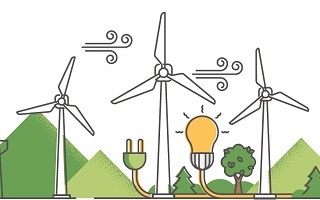Land Use

The Council can utilise our land to support our carbon aims. We can do this through investment in renewable energy, and planting schemes to support carbon absorption and improvement and maintenance of our biodiversity. The Council has worked on large scale projects to increase our renewable energy generation, however in order to reach our ambitious goals of decarbonisation more large scale projects will need to be developed. The following solutions have been proposed to support our decarbonisation goals through our land use.
- Own and operate 2 landfill gas engines which generate low carbon electricity and are now complemented by 2 solar farms. These all power on site facilities as well as the nearby waste transfer station.
- The construction of an additional two solar farms, with a combined generation capacity of 3.5MW.
- Trialling different grass cutting regimes on the Council’s verges and green spaces to encourage and enhance biodiversity.
- Developed a 15 year Urban Tree and Woodland Plan with the target of achieving 18% urban canopy cover by 2033. Objectives of the plan are to increase the amount of tree planting by specifically targeting urban areas with low canopy cover, ensuring existing canopy cover is managed sustainably, promoting biodiversity and working in partnership. The Council has been working with Community Groups, Natural Resources Wales and schools - planting trees in education and public land.
- Published our “Supporting nature in Flintshire” biodiversity duty plan and are working to support biodiversity protection and improvement in Flintshire.
- Working with hundreds of businesses, volunteers, charities, schools and other organisations, across the region of North Wales, Shropshire and Cheshire removing litter from the banks and tributaries of the River Dee.
- Countryside Services manages over 40 sites of natural greenspace including Wepre Park and Greenfield Valley Heritage Park, 1200 km public rights of way, 37 miles of Welsh Coastal Path, events and education programmes, and brings in external grants of over £400k per year connecting people to nature.
- The Council has protected our 120 play areas and invested over £2m in partnership with town and community councils over the last 8 years as well as ensuring free open access to greenspace.
- Through collaboration with regional partners and Welsh Government, the Council has managed the construction of an energy from waste facility, Parc Adfer, which will create electricity for 30,000 homes from waste that cannot be recycled. It will also help to prevent waste from going to landfill.
- Through the same partnership all of the Council’s food waste is taken to an anaerobic digester where it is used to produce electricity (via biogas) and liquid fertilizer, preventing food waste from going to landfill.
- Work is ongoing with Welsh Government Energy Service to determine feasibility of sites for further renewable energy generation.
- Sites have been identified for potential tree planting however further feasibility of these sites is needed.
- Use of herbicide and pesticide is being recorded, and where possible, use is rationalised and alternatives adopted.
- Network of 109 nature areas across county covering 11.8hectares – grassland estate with reduced mowing regime managed for wildflower diversity.
- Food growing sites have been receiving improvements such as water harvesting measures. Currently 16 food growing sites across the county covering 3.8 hectares with additional sites being identified.
- Review of recycling provision in Council buildings taking place in line with the new workplace recycling legislation. Trials of on-demand collections at schools are ongoing.
- Deconstruction and set aside available at household recycling centres for large household items to be repaired and reused or broken down into component parts for recycling. Working with Flintshire Refurbs and local charities to expand options for recovery of further items.
Future actions:
We will:
- Identify current carbon storage capacity within Council assets through mapping habitat types.
- Support the increase of tree canopy cover across the county in line with the Urban Tree and Woodland Plan.
- Assess impacts of Ash Dieback and tree planting within Flintshire assets on canopy cover and net carbon sequestration.
- Increase area with reduced mowing regimes to enhance biodiversity and increase carbon storage.
- Strengthen the monitoring of sustainable drainage systems (SuDs) installation and quality in new developments.
- Review and improve recycling provision in Council offices, schools and public buildings and remove use of single-use plastics. Communicate and engage building users to utilise provision.
- Create guidelines for Council procurement of food in offices, schools, etc, to be local and sustainable.